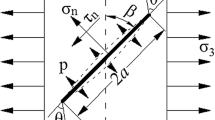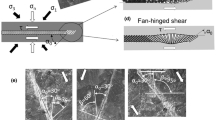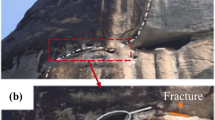Abstract
Field observations proved that tensile branches can be formed during fault growing and contribute with other types of fractures in creating a fractured zone around dynamic faults. In this study, the effects of rupture speed (c), initial stress ratio (σxxo/σyyo), and residual strength ratio (τr/τp) on the preferred direction of tensile branches around the main fault plane were investigated using the maximum tangential stress criterion (MTS-Criterion). The slip weakening model was used to regularize shear stress between fault surfaces. The analytical model indicated that tensile branches can grow through acute or obtuse angles in forward or backward directions in the extensional side of the fault, respectively. The low values of branching angle are accompanied by a high residual strength ratio, and vice versa for high values of branching angle. For rupture speeds less than 0.9 of the Rayleigh wave speed, the preferred direction of the new tensile branch is initially a function of the initial stress ratio, residual strength ratio and rupture speed. While for rupture speeds near the limiting velocity (χcr between 0.9 and 1.0), the preferred direction for the new tensile branch is independent of the initial stress state and residual strength ratio, and it is mainly a function of the rupture speed. The application of the preferred direction of tensile branches in geological and geophysical field was discussed and some field examples were shown here to validate the results of this study.







Similar content being viewed by others
Data availability
The datasets generated during and/or analyzed during the current study are available from the corresponding author on reasonable request.
References
Alneasan M, Behnia M (2022a) Analytical model for the activation of off-axis secondary faulting between two dissimilar rock layers. J Struct Geol 157:104552
Alneasan M, Behnia M (2022b) Analytical investigation on the effect of friction coefficient and crack inclination angle on the effective elastic properties and strength of brittle rocks. Innov Infrastruct Solut 7(5):1–11
Alneasan M, Behnia M, Alzo’ubi AK (2022) Experimental observations on the effect of strain rate on rock tensile fracturing. Int J Rock Mech Min 160:105256
Anders MH, Wiltschko DV (1994) Microfracturing, paleostress and the growth of faults. J Struct Geol 16(6):795–815
Barenblatt G, Cherepanov G (1960) On the wedging of brittle bodies. J Appl Math Mech 24(4):993–1015
Bhat HS, Olives M, Dmowska R, Rice JR (2007) Role of fault branches in earthquake rupture dynamics. J Geophys Res Solid Earth 112(B11)
Broberg KB (1960) The propagation of a brittle crack. Arkvik Fysik 18:159–192
Cai W, Dou L, Li Z, He J, He H, Ding Y (2015) Mechanical initiation and propagation mechanism of a thrust fault: a case study of the Yima section of the XIASHI-yima thrust (north side of the Eastern Qinling Orogen, China). Rock Mech Rock Eng 48(5):1927–1945
Cao P, Liu T, Pu C, Lin H (2015) Crack propagation and coalescence of brittle rock-like specimens with pre-existing cracks in compression. Eng Geol 187:113–121
Dalguer L, Irikura K, Riera J (2003) Simulation of tensile crack generation by three‐dimensional dynamic shear rupture propagation during an earthquake. J Geophys Res Solid Earth 108(B3)
Di Toro G, Nielsen S, Pennacchioni G (2005) Earthquake rupture dynamics frozen in exhumed ancient faults. Nature 436(7053):1009–1012
Dublanchet P (2019) Fluid driven shear cracks on a strengthening rate-and-state frictional fault. J Mech Phys Solids 132:103672
Erdogan F, Sih G (1963) On the crack extension in plates under plane loading and transverse shear. J Basic Eng 85(4):519–525
Fliss S, Bhat HS, Dmowska R, Rice JR (2005) Fault branching and rupture directivity. J Geophys Res Solid 110(B6)
Freund LB (1998) Dynamic fracture mechanics. Cambridge University Press, Cambridge
Griffith WA, Di Toro G, Pennacchioni G, Pollard DD (2008) Thin pseudotachylytes in faults of the Mt. Abbot Quadrangle, Sierra Nevada: physical constraints for small seismic slip events. J Struct Geol 30(9):1086–1094
Griffith WA, Rosakis A, Pollard DD, Ko CW (2009) Dynamic rupture experiments elucidate tensile crack development during propagating earthquake ruptures. Geology 37(9):795–798
Ida Y (1973) The maximum acceleration of seismic ground motion. Bull Seismol Soc Am 63(3):959–968
Kame N, Rice JR, Dmowska R (2003) Effects of prestress state and rupture velocity on dynamic fault branching. J Geophys Res Solid Earth 108(B5)
Lee J, Hong J-W, Jung J-W (2017) The mechanism of fracture coalescence in pre-cracked rock-type material with three flaws. Eng Geol 223:31–47
Lo C, Nakamura T, Kushner A (1994) Computational analysis of dynamic crack propagation along a bimaterial interface. Int J Solids Struct 31(2):145–168
Ma X, Elbanna A (2019) Dynamic rupture propagation on fault planes with explicit representation of short branches. Earth Planet Sci Lett 523:115702
Ngo D, Huang Y, Rosakis A, Griffith W, Pollard D (2012) Off‐fault tensile cracks: A link between geological fault observations, lab experiments, and dynamic rupture models. J Geophys Res Solid Earth 117(B1)
Palmer AC, Rice JR (1973) The growth of slip surfaces in the progressive failure of over-consolidated clay. Proc R Soc Lond A Math Phys Sci 332(1591):527–548
Poliakov AN, Dmowska R, Rice JR (2002) Dynamic shear rupture interactions with fault bends and off-axis secondary faulting. J Geophys Res Solid 107(B11):6-1–6-18
Rice J (1979) The mechanics of earthquake rupture, Division of Engineering. Brown University, Providence
Rice J (2000) Fracture energy of earthquakes and slip-weakening rupture parameters. Eos Trans AGU 81(48)
Rosakis A, Samudrala O, Coker D (1999) Cracks faster than the shear wave speed. Science 284(5418):1337–1340
Ruedas T, Schmeling H (2008) On the orientation of tensile dikes in a ridge-centered plume. Tectonophysics 447(1–4):19–30
Svetlizky I, Fineberg J (2014) Classical shear cracks drive the onset of dry frictional motion. Nature 509(7499):205–208
Swanson MT (1988) Pseudotachylyte-bearing strike-slip duplex structures in the Fort Foster Brittle Zone, S. Maine. J Struct Geol 10(8):813–828
Tarasov B (2016) Shear fractures of extreme dynamics. Rock Mech Rock Eng 49(10):3999–4021
Wu Z, Wong LNY (2013) Modeling cracking behavior of rock mass containing inclusions using the enriched numerical manifold method. Eng Geol 162:1–13
Yamashita T (2000) Generation of microcracks by dynamic shear rupture and its effects on rupture growth and elastic wave radiation. Geophys J Int 143(2):395–406
Funding
The authors have not disclosed any funding.
Author information
Authors and Affiliations
Contributions
Mahmoud Alneasan: Methodology, Software, Validation, Formal analysis, Investigation, Writing—Original Draft, Visualization. Mahmoud Behnia: Conceptualization, Resources, Data Curation, Writing—Review and Editing, Supervision, Project administration, Funding acquisition.
Corresponding author
Ethics declarations
Conflict of interest
No funding was received to assist with the preparation of this manuscript.
Additional information
Publisher's Note
Springer Nature remains neutral with regard to jurisdictional claims in published maps and institutional affiliations.
Rights and permissions
Springer Nature or its licensor (e.g. a society or other partner) holds exclusive rights to this article under a publishing agreement with the author(s) or other rightsholder(s); author self-archiving of the accepted manuscript version of this article is solely governed by the terms of such publishing agreement and applicable law.
About this article
Cite this article
Alneasan, M., Behnia, M. Analytical simulation of mode I fracture generation from dynamic frictional surfaces governed by slip weakening model. Environ Earth Sci 83, 11 (2024). https://doi.org/10.1007/s12665-023-11311-5
Received:
Accepted:
Published:
DOI: https://doi.org/10.1007/s12665-023-11311-5




